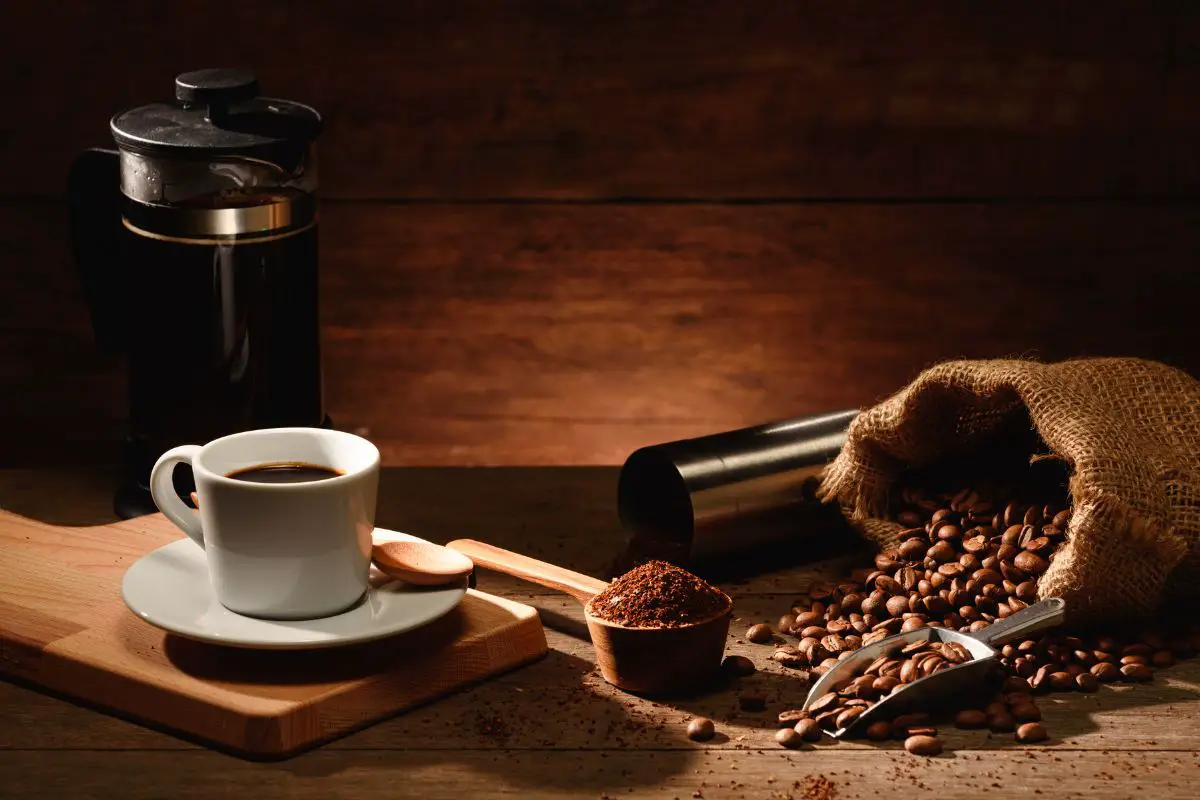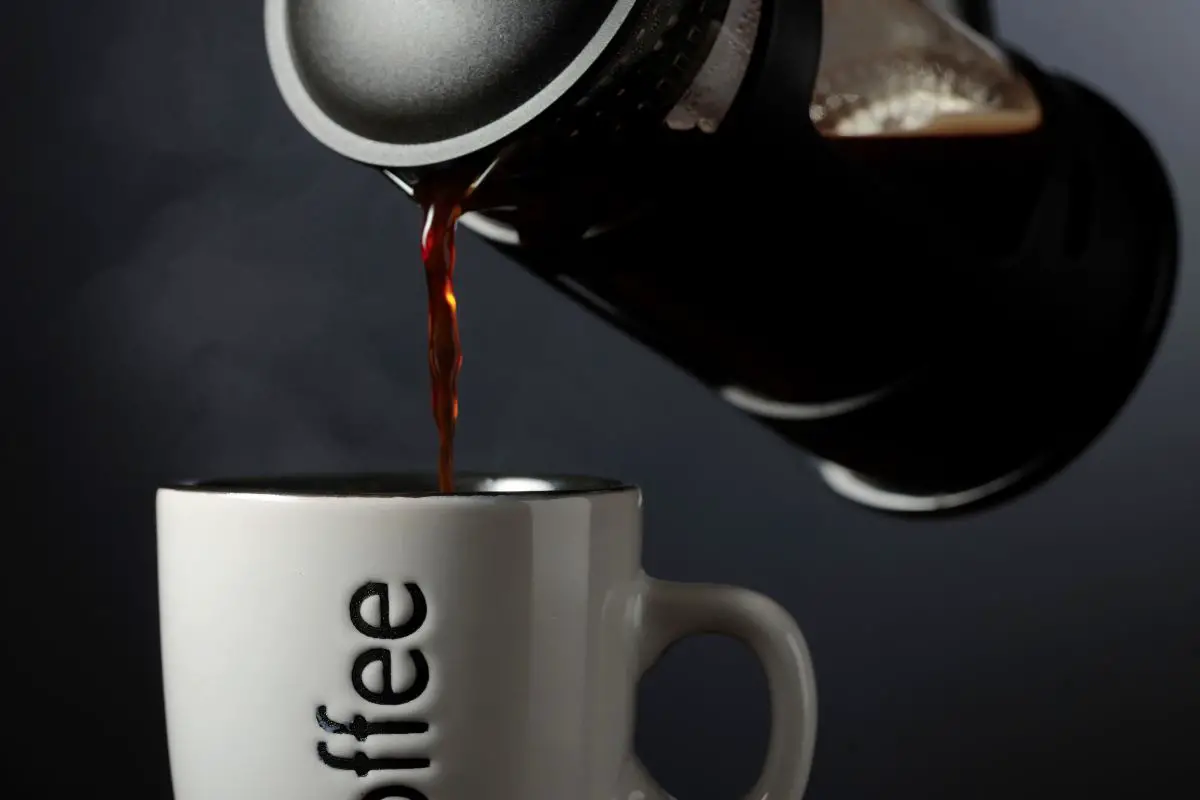Coffee lovers are constantly seeking new ways to enjoy their favorite beverage, and brewing espresso in a French press offers a unique and flavorful experience. Just as a painter uses different brushes to create various strokes, coffee enthusiasts can explore the versatility of their French press to produce a rich and robust cup of espresso.

Unlike traditional coffee, espresso is a concentrated form of coffee that is brewed under higher pressure, resulting in a bold and intense flavor profile. By using the correct coffee beans, grinding them to the appropriate consistency, and following precise brewing techniques, one can achieve a homemade espresso that rivals the quality of a professional coffee shop.
This article will guide you through the process of brewing espresso in a French press, providing detailed instructions to ensure a safe and satisfying brewing experience. So, grab your French press and let’s embark on a journey to discover the art of making espresso at home.
Key Takeaways
- Choosing the right coffee beans, such as Arabica beans and dark roast, is crucial for flavor and strength in brewing espresso in a French press.
- Grinding the whole beans to a fine to medium-fine consistency is important for proper extraction.
- Heating water to a temperature between 195°F and 205°F is recommended for optimal flavor extraction.
- Preheating the French press, using a metal mesh filter, and following the brewing parameters of 1:15 coffee-to-water ratio and 4 minutes brew time are essential for brewing espresso in a French press successfully.
Understand the Difference Between Regular Coffee and Espresso
The distinction between regular coffee and espresso lies in the brewing method, with regular coffee being brewed using a drip or filter process, while espresso is made by forcing pressurized hot water through finely ground coffee beans.
The drip or filter process used in regular coffee brewing involves pouring hot water over coffee grounds and allowing it to slowly pass through a filter, extracting the flavors and aromas. This method typically results in a milder and less concentrated coffee beverage.
On the other hand, espresso is brewed using a machine that forces hot water at high pressure through finely ground coffee beans. This process extracts more flavor and caffeine from the coffee beans, resulting in a strong and concentrated shot of espresso. The high pressure used in espresso brewing also contributes to the formation of crema, a layer of foam on top of the espresso shot that adds to its rich and velvety texture.
To transition into the subsequent section, it is important to choose the right coffee beans for espresso in a french press, as the quality and type of beans greatly impact the flavor and strength of the final beverage.
Choose the Right Coffee Beans for Espresso in a French Press
To optimize the quality of the brewed beverage, selecting the appropriate coffee beans for a specific brewing method is crucial; a study by Coffee Science found that using freshly roasted Arabica beans resulted in a higher extraction yield compared to Robusta beans.
When making espresso in a French press, it is important to choose coffee beans that are specifically labeled as espresso or dark roast. These beans are typically roasted longer and have a more intense flavor profile, making them ideal for espresso brewing. Additionally, it is recommended to select beans that are of high quality and sourced from reputable coffee farms. This ensures that the beans are grown under optimal conditions and harvested at the right time, resulting in a more flavorful cup of espresso.
Furthermore, it is advisable to purchase whole beans and grind them just before brewing, as this helps to preserve the freshness and aroma of the coffee. Grinding the beans to the correct consistency, which is fine to medium-fine, allows for proper extraction of flavors during the brewing process.
Transitioning into the next section, grinding the beans to the correct consistency is essential for achieving the perfect cup of espresso in a French press.
Grind Your Coffee Beans to the Correct Consistency
Achieving the perfect cup of coffee requires grinding the coffee beans to the correct consistency. The grind size plays a crucial role in the extraction process, as it determines the surface area of the coffee exposed to water. For espresso in a French press, a coarse grind is recommended to prevent over-extraction and bitterness. This allows for a slower extraction process, resulting in a smoother and well-balanced cup of coffee.
To ensure consistency in grind size, it is important to use a burr grinder rather than a blade grinder. Burr grinders offer more control and produce a uniform grind, whereas blade grinders can create uneven particles. The table below illustrates the different grind sizes for various brewing methods:
| Grind Size | Brewing Method |
|---|---|
| Coarse | French Press |
| Medium | Drip Coffee |
| Fine | Espresso |
| Extra-fine | Turkish Coffee |
By using the correct grind size for your brewing method, you can maximize flavor extraction and avoid any safety concerns associated with under-extraction or over-extraction. Once the beans are ground to the correct consistency, the next step is to heat the water to the ideal temperature for achieving the perfect cup of espresso in a French press.
Heat the Water to the Ideal Temperature
Optimal flavor extraction can be achieved by carefully controlling the water temperature during the brewing process. It is crucial to heat the water to the ideal temperature in order to produce a rich and flavorful espresso in a French press.
The recommended water temperature for brewing espresso is between 195°F (90.6°C) and 205°F (96.1°C). This range ensures that the coffee grounds are properly extracted, releasing their full aroma and flavor.
Heating the water to the correct temperature is important for several reasons. Firstly, too low a temperature will result in under-extraction, leading to a weak and insipid espresso. On the other hand, water that is too hot can scorch the coffee grounds, resulting in a bitter and unpleasant taste. By maintaining the water temperature within the recommended range, you can strike a balance between extracting the desirable compounds from the coffee and avoiding any undesirable flavors.
To heat the water to the ideal temperature, you can use a thermometer to monitor the temperature closely. Alternatively, you can bring the water to a boil and then allow it to cool off for a few seconds before pouring it over the coffee grounds. This method ensures that the water reaches the desired temperature range.
With the water at the optimal temperature, you are now ready to brew the espresso in your French press, extracting the full potential of the coffee grounds.
Brew the Espresso in Your French Press

Brewing a robust and flavorful cup of coffee in the French press requires careful attention to the extraction process. To achieve the perfect espresso, it is essential to follow the proper brewing technique. Here, we will discuss how to brew espresso in your French press.
First, ensure that you have preheated your French press by rinsing it with hot water. This step helps maintain the optimal brewing temperature. Next, measure out the desired amount of coffee grounds and add them to the French press. For a strong and bold flavor, a ratio of 1:15 coffee to water is recommended.
The table below illustrates the brewing parameters for a successful espresso extraction in a French press.
| Brewing Parameters | Ideal Range |
|---|---|
| Coffee-to-Water Ratio | 1:15 |
| Water Temperature | 195-205°F (90-96°C) |
| Brew Time | 4 minutes |
| Plunge Pressure | Gentle and steady |
| Filter Type | Metal mesh filter |
Once all the components are in place, pour the hot water over the coffee grounds, ensuring that they are fully saturated. Allow the espresso to brew for approximately four minutes, and then slowly press down the plunger. This gentle and steady plunge will separate the brewed coffee from the grounds, leaving you with a rich and flavorful espresso.
With your homemade espresso ready, it’s time to serve and enjoy. Transitioning into the subsequent section, we will explore tips for enhancing the taste and presentation of your espresso.
Serve and Enjoy Your Homemade Espresso
To fully savor the rich flavors and aromatic profile of a homemade cup of coffee, it is essential to appreciate the art of serving and enjoying this meticulously crafted beverage.
After brewing the espresso in your French press, it is important to serve it correctly to ensure the best possible taste and experience.
Firstly, pour the brewed espresso immediately after pressing it into preheated cups. This will help maintain the optimal temperature of the coffee and preserve its flavors. It is also recommended to use cups made of a material that retains heat well, such as ceramic or glass, to further enhance the overall coffee-drinking experience.
Next, consider adding a touch of sweetness to your espresso by serving it with a piece of dark chocolate or a small biscotti on the side. The bitterness of the dark chocolate complements the rich flavors of the espresso, while the biscotti provides a delightful crunch.
Lastly, take a moment to appreciate the aroma of the freshly brewed coffee before taking your first sip. Inhaling the fragrance can enhance the overall sensory experience and prepare your taste buds for the rich flavors that await. When sipping the espresso, take small, deliberate sips to fully appreciate the complexity of the flavors.
By following these serving suggestions, you can ensure that your homemade espresso is enjoyed to its fullest potential, creating a delightful and safe coffee-drinking experience.
Frequently Asked Questions
Can I use regular coffee beans instead of espresso beans in a French press?
Yes, regular coffee beans can be used in a French press instead of espresso beans. However, the resulting brew may have a different flavor profile due to variations in roast level and grind size.
How long should I let the coffee steep in the French press to make espresso?
To achieve the optimal flavor and strength, it is recommended to let the coffee steep in a french press for approximately four minutes. This duration allows for the extraction of the rich flavors and aromas from the coffee grounds, resulting in a satisfying cup of coffee.
Can I use pre-ground coffee for making espresso in a French press?
Using pre-ground coffee in a French press can result in a suboptimal espresso experience. The lack of control over the grind size may lead to under-extraction or over-extraction, affecting the taste and quality of the final product.
What is the ideal water-to-coffee ratio for brewing espresso in a French press?
The ideal water-to-coffee ratio for brewing espresso in a French press is 1:15. This ratio ensures a balanced and flavorful extraction, while avoiding over-extraction that can result in a bitter taste.
Can I reuse the coffee grounds from a previous French press brew to make espresso?
Reusing coffee grounds from a previous brew to make espresso is not recommended. This practice can lead to a decrease in flavor quality and potentially introduce harmful bacteria. It is advisable to use fresh coffee grounds for each brew.
Conclusion
In conclusion, when making espresso in a French press, it is important to understand the difference between regular coffee and espresso.
Choosing the right coffee beans and grinding them to the correct consistency are crucial steps in achieving a rich and flavorful espresso.
Heating the water to the ideal temperature and brewing the espresso in the French press further enhance the taste.
By following these steps, you can enjoy a homemade espresso that rivals that of a professional coffee shop.
Interestingly, a study found that 54% of coffee drinkers prefer espresso-based drinks over regular coffee, highlighting the popularity of espresso.
Related articles:
Can You Make Espresso In A Keurig?